

Pre-Service Teachers Designing Virtual World Learning Environments. JRC56958. JRC66836. Investigating models for preservice teachers’ use of technology to support student-centered learning. Rong-Ji Chen, California State University San Marcos, College of Education, 333 S.
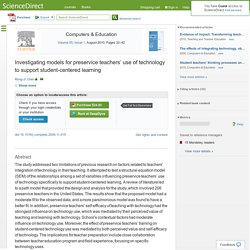
Twin Oaks Valley Road, San Marcos, CA 92096, USA Received 28 August 2009, Revised 28 November 2009, Accepted 30 November 2009, Available online 5 December 2009 Choose an option to locate/access this article: Check if you have access through your login credentials or your institution Check access doi:10.1016/j.compedu.2009.11.015 Get rights and content. Modelling technology acceptance in education: A study of pre-service teachers. Timothy Teo, Learning Sciences and Technologies Academic Group, National Institute of Education, Nanyang Technology University, 1 Nanyang Walk, Singapore 637616, Singapore Received 20 November 2007, Revised 25 August 2008, Accepted 28 August 2008, Available online 11 October 2008.
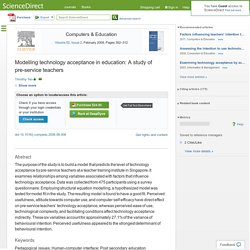
Education Research Highlights From 2015. 2015 was a great year for education research. fMRI technology gave us new insight into how exercise can improve math ability by changing the structure of children's brains (#13 below).

We saw how Sesame Street's 40-year history has made an impact on preparing young children for school (#7). Several studies reinforced the importance of social and emotional learning for students (#2, 5, and 9). Two must-read publications were released to help educators understand how students learn (#4 and 11). Here are 15 studies published this year that every educator should know about. 1.
A classroom's physical learning space makes a difference in how well students learn. The Do's and Don'ts for Teachers on Social Media Infographic. Teacher Infographics.
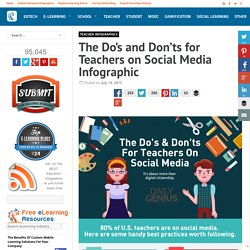
Google_cheat_sheets_ebook. The Golden Treasures of Google! The Fabulous Tools You Don't Know About! Google Tricks and Tips. Factors influencing teachers’ intention to use technology: Model development and test. Timothy Teo, National Institute of Education, Nanyang Technological University, 1 Nanyang Walk, Singapore 637616, Singapore Received 29 December 2010, Revised 14 June 2011, Accepted 14 June 2011, Available online 21 June 2011 Choose an option to locate/access this article: Check if you have access through your login credentials or your institution Check access doi:10.1016/j.compedu.2011.06.008 Get rights and content.
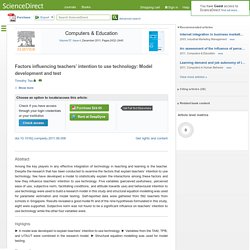
Predicting secondary school teachers’ acceptance and use of a digital learning environment: A cross-sectional study. Volume 27, Issue 1, January 2011, Pages 568–575 Current Research Topics in Cognitive Load Theory Third International Cognitive Load Theory Conference Edited By Femke Kirschner, Gemma Corbalan and Liesbeth Kester.

Teachers’ opinion survey on the use of ICT tools to support attendance-based teaching. Department of Psychology and Sociology, Universidad de Las Palmas de Gran Canaria (ULPGC), 35004, Spain Received 10 May 2010, Revised 19 October 2010, Accepted 4 November 2010, Available online 12 November 2010 Choose an option to locate/access this article: Check if you have access through your login credentials or your institution Check access doi:10.1016/j.compedu.2010.11.005 Get rights and content Abstract.

Predicting secondary school teachers’ acceptance and use of a digital learning environment: A cross-sectional study. Sign In. About — Connectivism. Description of Connectivism Connectivism is a learning theory for the digital age.

Learning has changed over the last several decades. The theories of behaviourism, cognitivism, and constructivism provide an effect view of learning in many environments. Internal Validity. Construct Validity. « PreviousHomeNext » Construct validity refers to the degree to which inferences can legitimately be made from the operationalizations in your study to the theoretical constructs on which those operationalizations were based.
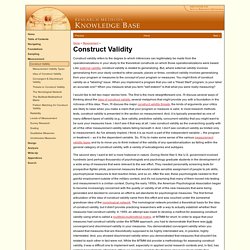
Like external validity, construct validity is related to generalizing. But, where external validity involves generalizing from your study context to other people, places or times, construct validity involves generalizing from your program or measures to the concept of your program or measures. You might think of construct validity as a "labeling" issue. When you implement a program that you call a "Head Start" program, is your label an accurate one? I would like to tell two major stories here. The second story I want to tell is more historical in nature. Copyright �2006, William M.K. Download. ‘To play or not to play’: A cross-temporal investigation using hedonic and instrumental perspectives to explain user intentions to explore a technology. Abstract The present research extends prior work on the relationship between users and technology by examining users’ intention to explore a technology.
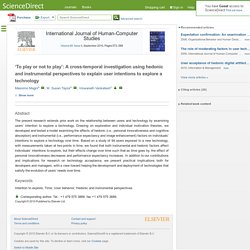
Drawing on exploration and individual motivation theories, we developed and tested a model examining the effects of hedonic (i.e., personal innovativeness and cognitive absorption) and instrumental (i.e., performance expectancy and image enhancement) factors on individuals’ intentions to explore a technology over time. Based on a study of 94 users exposed to a new technology, with measurements taken at two points in time, we found that both instrumental and hedonic factors affect individuals’ intentions to explore, but their effects change over time such that as time goes by, the effect of personal innovativeness decreases and performance expectancy increases. MishraKoehler_AERA2008.pdf. Student teachers’ thinking processes and ICT integration: Predictors of prospective teaching behaviors with educational technology. Abstract Student teachers should be prepared to integrate information and communication technology (ICT) into their future teaching and learning practices.
Despite the increased availability and support for ICT integration, relatively few teachers intend to integrate ICT into their teaching activities (e.g., Ertmer, 2005). The available research has thus far mainly focused on isolated teacher related variables to explain the weak level of ICT integration. Mishra-koehler-tcr2006.pdf. An Error Occurred Setting Your User Cookie. Exploring user acceptance of technology using social networks. Abstract The technology acceptance model (TAM) has been widely used to study user acceptance of new computer technologies. However, it does not incorporate social structure and influence as a significant factor. In this study, we ask the following questions: (i) What are the limitations of the existing TAM for studying virtual community? Exploring user acceptance of technology using social networks.
Chen_2010_SEM.pdf. Standards for Teachers. 20-14_ISTE_Standards-T_PDF.pdf. How The Activity Learning Theory Works. How The Activity Learning Theory Works by Steve Wheeler, Associate Professor, Plymouth Institute of Education This is number 8 in my series on learning theories. My intention is to work through the alphabet of psychologists and provide a brief overview of each theory, and how it can be applied in education. In the last post we examined the various educational theories of John Dewey including experiential learning.
Chen_2010_SEM.pdf. EJ951442.pdf. Assessing Faculty's Technology Needs. Key Takeaways A center for teaching excellence can ease the transition to the 21st century classroom by responding to faculty needs. The University of South Carolina's Center for Teaching Excellence investigated faculty's training needs in order to integrate technology into the classroom. Beyond Technology: Children's Learning in the Age of Digital Culture - David Buckingham - Google Books. Beyond Technology: Childrens Learning in the Age of Digital Culture offers a challenging new analysis of learning, young people and digital media. Disputing both utopian fantasies about the transformation of education and exaggerated fears about the corruption of childhood innocence, it offers a level-headed analysis of the impact of these new media on learning, drawing on a wide range of critical research.
Buckingham argues that there is now a growing divide between the media-rich world of childrens lives outside school and their experiences of technology in the classroom. Bridging this divide, he suggests, will require more than superficial attempts to import technology into schools, or to combine education with digital entertainment. While debunking such fantasies of technological change, Buckingham also provides a constructive alternative, arguing that young people need to be equipped with a new form of digital literacy that is both critical and creative. GamesSimsSocNets_EdArcade.pdf. Viewcontent. Jlt_15_1_shirvani.pdf. Viewcontent. TATTO004. UoM IT Account - University of Malta. Teacher efficacy in Teaching and Teacher Education.
Review Robert C. Why do I need a teacher when I’ve got Google? The essential guide to the big issues for every twenty- first century teacher by I. Gilbert. The book entitled ‘Why do I need a teacher when I’ve got Google?’ Includes discrete chapters focusing on questions and issues on education, which the author, Ian Gilbert considers pivotal in today’s twenty-first education. Abbitt.pdf.